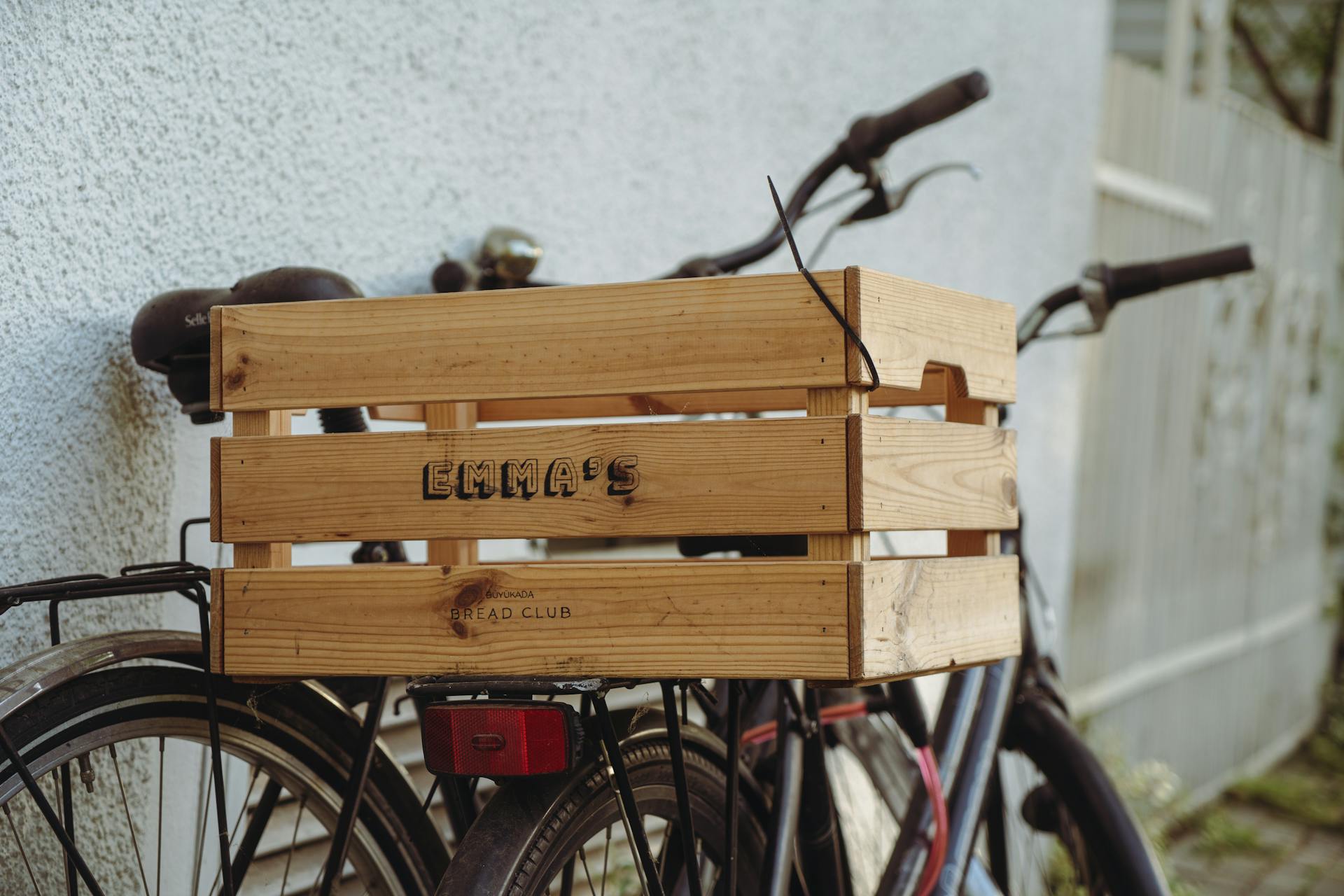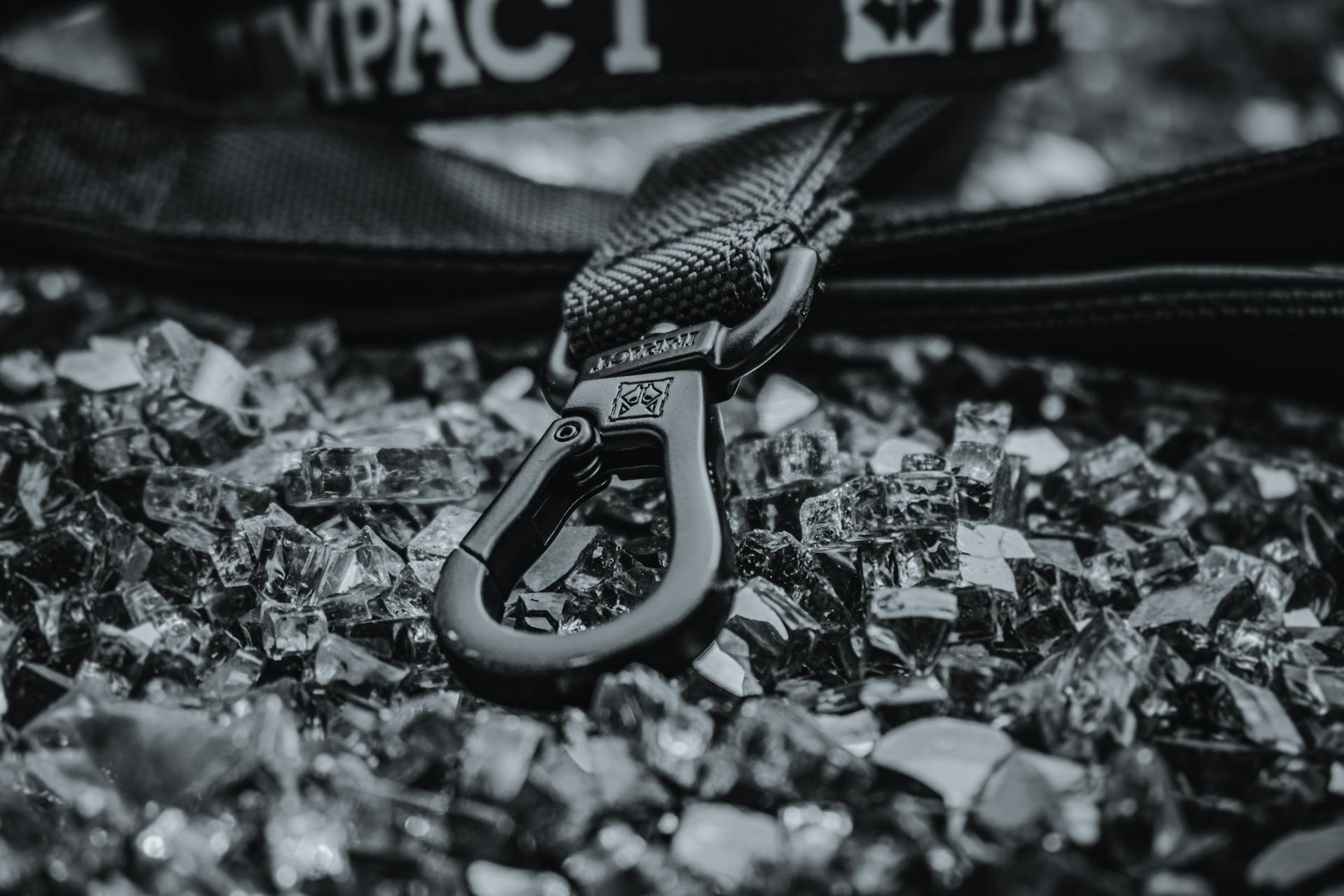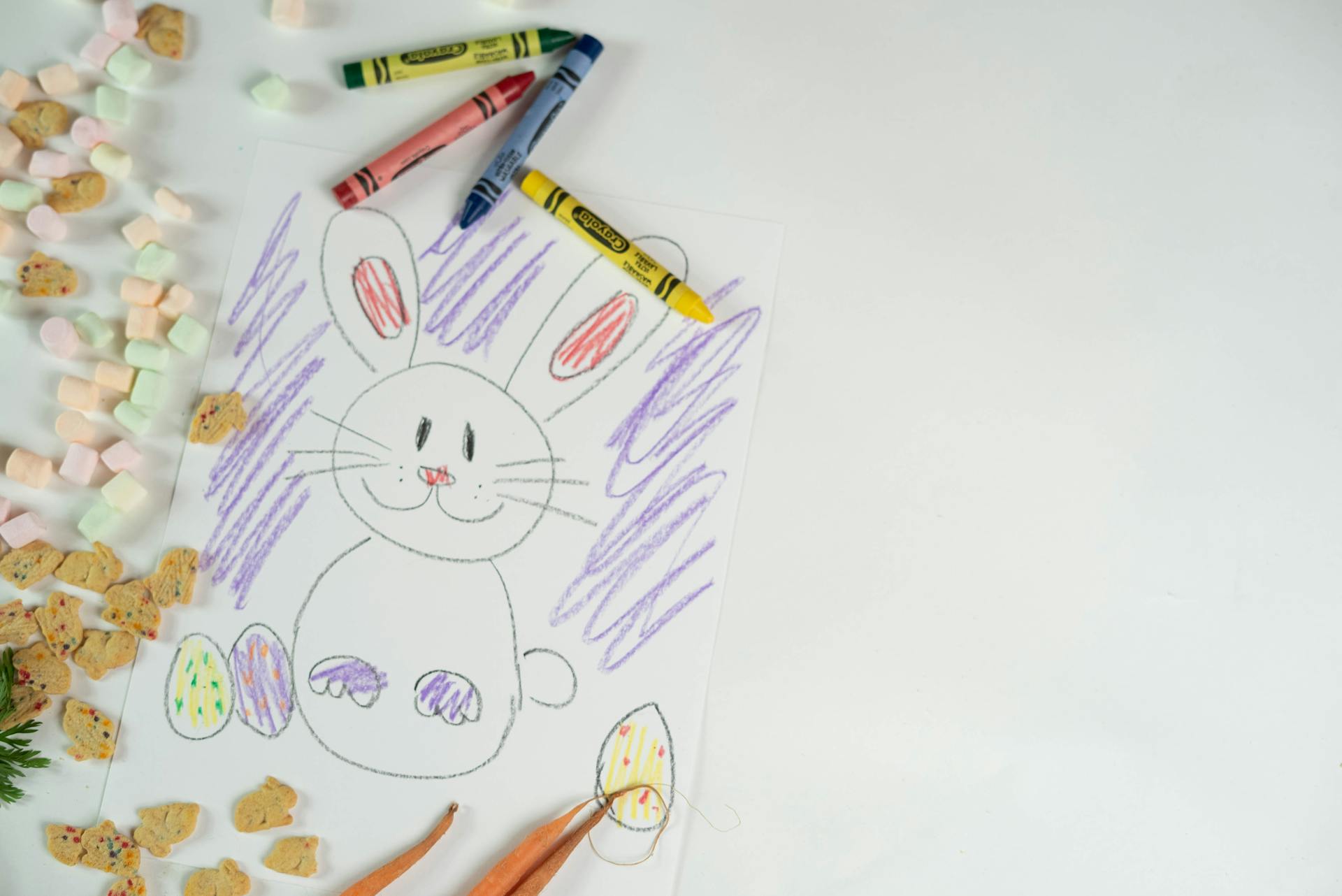
Crate training during the day can be a game-changer for dogs with separation anxiety. According to studies, crate training can reduce separation anxiety symptoms in dogs by up to 70%.
By providing a safe and comfortable space for your dog to relax in, you can help alleviate their anxiety and stress. This is especially true for dogs that are prone to destructive behavior when left alone.
Dogs that are crate-trained during the day tend to be less anxious and more relaxed when their owners are away. They also tend to have fewer accidents in the house, which can be a major relief for pet owners.
Crate training can also help to establish a routine and provide a sense of security for your dog. This is crucial for dogs with separation anxiety, who often thrive on predictability and structure.
For your interest: Dog Aggression during Human Pregnancy
Crating for Separation Anxiety
Crating can be a great tool to help prevent separation anxiety behaviors like pacing, looking out windows, and barking at passersby.
Being confined to a crate can actually be distressing for dogs who aren't accustomed to it, so it's essential to introduce crate time gradually.
You can start by crating your dog for a few minutes at a time while you're home, perhaps while you're busy cooking or cleaning.
If your dog is prone to destructive behavior, crating can keep them from getting hurt by keeping them away from hazardous areas like the kitchen or bathroom.
It's also a good idea to have a quiet room available for your dog to retreat to, and a baby gate can be a good alternative to a crate if you're not ready to commit to crate training.
Explore further: Are Clickers Good for Dog Training
Choosing the Right Crate
Choosing the right crate is key to a successful crate training experience. The crate should be durable, comfortable, and flexible with whatever training you're doing. You don't want to buy a crate that's too big for your dog, as this can derail the potty-training process.
For dogs that prefer to sleep in the dark, kennel or airline-style dog crates are a good option. Wire dog crates, on the other hand, work best for other dogs and have more versatility when it comes to door placement and customizing the size of the interior with a divider.
The two main things to consider when choosing a crate are the type and size. There are two main types of crates: hard plastic airline-style crates and wire crates. Most pups can learn to be comfortable in either type, but wire crates are more versatile. For size, you want a crate that's large enough for your dog to stand up, turn around, and lie down comfortably, but not much bigger.
A different take: Two Dog Shock Collar
Choose the Right
Choosing the right crate for your dog is crucial for their comfort and safety. You want to get one that's durable, comfortable, and flexible with whatever training you're doing.
There are two main types of crates: hard plastic airline-style crates and wire crates. Wire crates are more versatile and have more door placement options, but either type can work for most dogs.
When selecting the right size, consider your dog's adult size. Buy a crate that's large enough for them to stand up, turn around, and lie down comfortably. Don't get a crate that's too big, as this can derail the potty-training process.
Here are some crate options to consider:
- Plastic (often called "flight kennels")
- Fabric on a collapsible, rigid frame
- Collapsible, metal pens
You can also consider renting a crate from your local animal shelter, especially if you have a growing puppy. This way, you can trade up to the right size as your dog grows.
Choosing the Right Crate
A crate that's too small can be uncomfortable for your dog, while one that's too large can make them feel anxious. The ideal crate size will depend on your dog's breed and size.
The crate should be well-ventilated to prevent your dog from getting too hot or stuffy. A crate mat is a good choice for pups still acclimating to the crate, as it's easy to clean and can help prevent accidents.
Treats can be an important part of the crate introduction process. Small savory treats, like Wellness Soft Puppy Bites Lamb & Salmon Recipe Grain-Free Dog Treats, help reinforce the idea that good things happen inside the crate.
The crate should be durable and able to withstand your dog's chewing. Busy toys, like treat-stuffable toys, can help keep your pup focused and happy until they drift off to sleep.
Here are some key things to consider when choosing a crate:
- Crate size: Consider your dog's breed and size when choosing a crate.
- Crate ventilation: Look for a crate that's well-ventilated to prevent your dog from getting too hot or stuffy.
- Crate material: Choose a crate made from durable materials that can withstand your dog's chewing.
Establish the Right Mindset
To establish the right mindset for crate training, it's essential to associate the crate with a relaxed mindset. This can be achieved by bringing your dog into the crate when they're calm, not when they're playing.
The more your dog associates the crate with relaxation, the more they'll enjoy spending time in it. Start by bringing them in for 10 minutes at a time and gradually increase the duration.
A crate becomes your dog's "happy place" when used properly. You can crate your dog for short periods while you're home to help them get accustomed to it.
Set Up for Success
To set up your home for successful crate training, it's essential to place the crate in a spot where your puppy feels close to you. Ideally, keep the crate in your bedroom or a nearby hallway, so your puppy can associate the crate with your presence.
Your puppy will feel more comfortable in the crate if it's in a room where you and your family spend the most time. This way, your puppy will still feel connected to you even when they're in their crate.
The most critical thing to remember is to never use the crate as a form of punishment. This can create negative associations and make crate training much more challenging.
Here are some guidelines for crate placement:
Remember to keep the crate in a safe and comfortable location, and avoid placing it near drafts or extreme temperatures. By following these tips, you'll be well on your way to setting up a successful crate training environment.
Introducing Your Puppy to the Crate
Introducing your puppy to the crate is a crucial step in crate training. Place the crate in an area of your house where the family spends a lot of time, such as the family room, and put a soft blanket or bed in it.
The crate should be open at first, allowing your puppy to explore it at their leisure. Some puppies will be naturally curious and start sleeping in the crate right away. If yours isn't one of them, don't worry!
To encourage your puppy to enter the crate, try dropping small food treats nearby, then just inside the door, and finally, all the way inside the crate. If they refuse to go all the way in at first, that's okay; don't force them to enter.
You can also try tossing a favorite toy in the crate to entice your puppy to go inside. This step may take a few minutes or as long as several days, so be patient.
A fresh viewpoint: Shock Collar Doesn T Phase Dog
Here are some tips to keep in mind:
- Keep the crate door propped open so that it doesn’t accidentally hit your pup and frighten them.
- Use positive reinforcement with treats or favorite toys to encourage your puppy to explore the crate.
- Don’t force your puppy to go inside the crate if they seem reluctant.
Remember, introducing your puppy to the crate is all about making it a positive experience for them. Stay happy and upbeat, and give lots of praise when they go inside.
Feeding and Comfort
Feeding your dog meals in the crate is a crucial step in crate training. This helps create a positive association with the crate, making it a comfortable space for your dog.
To start, place your dog's food dish near the crate, allowing them to associate the crate with meals. If your dog is readily entering the crate, you can place the food dish at the back of the crate. If they're reluctant, start with the dish closer to the door and gradually move it back as they become more comfortable.
Some dogs prefer hard surfaces, so you may not need to add a dog bed or towel. However, it's trial and error, and you may need to experiment to find what works best for your dog.
Check this out: How to Stop Dogs from Fighting over Food
If your dog is still hesitant to enter the crate, only place the food as far back as they're willing to go. Gradually increase the distance over time, and eventually, you can close the door while they eat.
To make crating during the day more comfortable, consider the following tips:
- Feed your dog about 10 minutes before you leave the house to ensure they have time to eliminate before you leave.
- Limit treats to a few snacks, as eating a full meal can cause them to need to eliminate soon after.
- Use calming aids like music therapy or lavender essential oil to promote relaxation.
- Provide a Kong toy filled with treats to keep your dog occupied while you're away.
Crating Periods and Time
Crating your dog during the day can be a great way to help with separation anxiety and destructive behavior. However, it's essential to establish a routine and gradually increase crating periods to prevent overwhelming your dog.
You can start by crating your dog for short periods while you're home, such as while you're cooking or cleaning. This will help them get used to the crate and reduce anxiety.
A good alternative to a crate is a baby gate used to keep your dog in a quiet room, away from dangerous places like the kitchen or bathroom.
To increase crating periods, practice with longer crating periods while you're home. Start by confining your dog to the crate for short periods, then gradually increase the length of time you leave them in the crate and the length of time you're out of sight.
Expand your knowledge: Canine Dimensions Home Dog Training
Here's a rough guide to help you increase crating periods:
Your dog needs time outside the crate to play, eat, and use the bathroom. Dogs don't want to soil where they sleep, but if there's too long of a stretch without a walk, they might end up doing so.
A full eight-hour workday is a long time for a dog to be in a crate without access to water or a way to eliminate. Limiting access to water can help prevent accidents, but if you'll be gone for more than just a few hours at a time, it's a good idea to make sure your dog has water.
Discover more: No Treat Dog Training
Leave Your Puppy Alone
Leaving your puppy alone can be challenging, but crate training can help. Start by crating your puppy when you leave the house, and begin with short periods of time, ideally 30 minutes, to help them feel comfortable.
You can put your puppy in the crate using your regular command and a treat, and vary the moment during your "getting ready to leave" routine that you put them in the crate. This can be anywhere from five to 20 minutes prior to leaving.
A different take: Will Spaying My Dog Help with Aggression
It's essential to make your departures matter-of-fact and avoid prolonged, emotional goodbyes. Praise your puppy briefly, give them a treat for entering the crate, and then leave quietly.
To help your puppy feel more comfortable in the crate, keep it in your bedroom or a nearby hallway. This will make them feel close to you, even when they're in their crate.
Here's a rough guide to help you gradually increase the amount of time your puppy is left alone:
Remember to reward your puppy for calm behavior, and avoid responding to excited behavior by reacting enthusiastically. Keep arrivals low-key to avoid increasing their anxiety over when you will return.
Establishing a Comfort Zone
To establish a comfort zone for your dog, it's essential to create a relaxed mindset around the crate. The more your dog associates the crate with a relaxed mindset, the more they'll enjoy hanging out in there.
You can start by bringing your dog into the crate when they're calm, as this will help them view it as a place of rest. This approach is more effective than putting them in the crate when they're playing, which might make them want to come back out and continue playing.
Dogs may have different preferences when it comes to comfort, so it's trial and error to find what works best for them. Some dogs may enjoy sleeping on a dog bed or towel, but others might not.
Dogs actually do prefer hard surfaces, so you might not need to add any extra comfort items to the crate. In fact, using dog beds or towels might not always be the best option, as your dog might tear them apart or use them to pee on.
Starting with short periods, like 10 minutes at a time, can help your dog get used to the crate and establish a comfort zone. As they become more comfortable, you can gradually increase the time.
Consider reading: Are German Shepherds Clingy
Tips and Reminders
Crate training can be a long process, so be patient. It's normal to feel like you're not making progress, but with consistent effort, your dog will eventually understand what's expected of them.
Remember that dogs aren't linear learners, so don't get discouraged if they don't pick things up right away. Success will come with time and patience.
To see progress, you'll need to stay calm and consistent in your methodology. This will help your dog look for the reward, and you can then reward them for their good behavior.
It's essential to prepare yourself for at least six months of crate training. This will give you and your dog the time you need to work through the ups and downs of the process.
For more insights, see: Will Getting a Male Dog Fixed Help with Aggression
Frequently Asked Questions
Can I move my dogs crate during the day?
Yes, you can move your dog's crate during the day, but it's best to keep it in a location where your puppy can easily see and be close to you.
Can I crate my dog all day while I work?
You can safely crate your dog during the day while you work, as long as they receive plenty of freedom and attention when you're home. However, crating all day may not be suitable for every dog, so it's essential to consider their individual needs and personality.
Sources
- https://healthyhoundz.com/2020/11/should-i-crate-my-dog-during-the-day-while-im-at-work/
- https://www.humanesociety.org/resources/crate-training-101
- https://www.akc.org/expert-advice/training/how-to-crate-train-your-dog-in-9-easy-steps/
- https://www.petmd.com/dog/general-health/crate-training-puppies
- https://be.chewy.com/how-to-crate-train-a-puppy-a-step-by-step-guide-from-an-expert/
Featured Images: pexels.com


